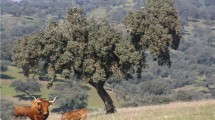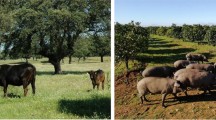Abstract
Conversion to OF was simulated for four specialized suckler-beef systems by coupling an economic optimization model (“Opt’INRA”) with a model assessing non-renewable energy (NRE) consumption and greenhouse gas (GHG) emissions (“PLANETE”). After adaptation of the production system, and based on average prices over 2004–2008, we analyzed the productive, environmental and economic impacts of the conversion process. The ban on chemical fertilizers led to a drop in farm area productivity. For these specialized farms, meat production decreased by 18% to 37% depending on initial level of intensification. The reduced use of inputs results in a 23% to 45% drop in NRE consumption/ha, 5–20% of which is a drop in NRE per ton of live weight produced. Its methane production makes cattle the biggest driver of GHG emissions. The shift to OF does not significantly affect gross GHG emissions per ton of live weight produced, but taking into account carbon sequestration in grasslands suggests net GHG emissions could be lower for OF systems. The lower productivity per hectare (less animals reared per hectares) allows a 26% to 34% reduction in net GHG emissions per hectare of farm area. Economically, the drop in productivity is not compensated by the gain in the meat selling price (+5% to +10%), gross farm product drops by 9% to 16%, and the lower use of inputs creates a strong −9% to −52% drop in operational costs. Farm income falls more than 20% (−7 to −46%).

Similar content being viewed by others
References
Arrouays D, Balesdent J, Germon JC, Jayet PA, Soussana JF, Stengel P (2002) Contribution à la lutte contre l’effet de serre. Stocker du carbone dans les sols agricoles de France? Expertise scientifique collective. Rapport INRA 332p
Azeez GSE (2008) The comparative energy efficiency of organic farming. International Conference on Organic Agriculture and Climate Change, Enita—Clermont, ABio Doc, France, April 17–18th
Basset-Mens C, Van der Werf H (2005) Scenario-based environmental assessment of farming systems: the case of pig production in France. Agric Ecosyst Environ 105:127–144
Beauchemin KA, Janzen HH, Shannan ML, McAllister TA, McGinn SM (2010) Life cycle assessment of greenhouse gas emissions from beef production in Western Canada: a case study. Agric Syst. doi:10.1016/j.agsy.2010.03.008
Bengtsson J, Ahnström J, Weibull AC (2005) The effects of organic agriculture on biodiversity and abundance: a meta-analysis. J Appl Ecol 42(2):2611–269
Benoit M, Veysset P (2003) Conversion of cattle and sheep suckler farming to organic farming: adaptation of the farming system and its economic consequences. Livest Prod Sci 80:141–152
Beukes PC, Cowling RM, Higgins SI (2002) An ecological economic simulation model of a non-selective grazing system in the Nama Karoo, South Africa. Ecol Econ 42:221–242
Bochu JL (2002) PLANETE: Méthode pour l’analyse énergétique des exploitations agricoles et l’évaluation des émissions de gaz à effet de serre. Colloque national: Quels diagnostics pour quelles actions agroenvironnementales? 10 & 11 October, Solagro, 68–80
Bochu JL (2007) Synthèse 2006 des bilans PLANETE. Consommation d’énergie et émissions des GES des exploitations agricoles ayant réalisé un bilan PLANETE. Rapport final. ADEME, Ministère de l’Agriculture et de la Pêche
Casey JW, Holden NM (2006a) Quantification of GHG emissions from suckler-beef production in Ireland. Agric Syst 90:79–98
Casey JW, Holden NM (2006b) Greenhouse gas emissions from conventional, agri-environmental scheme, and organic Irish suckler-beef units. J Environ Qual 35:231–239
Cederberg C, Mattsson B (2000) Life cycle assessment of milk production—a comparison of conventional and organic farming. J Cleaner Prod 8:49–60
Cederberg C, Stadig M (2003) System expansion and allocation in life cycle assessment of milk and beef production. Int J Life Cycle Assess 8(6):350–356
Chapelle C (2003) Des nitrates agricoles à l’Ouest et dans les plaines céréalières. Ministère de l’Alimentation de l’Agriculture et de la Pêche, Agreste Primeur, 123
CITEPA (2009) Inventaire des émissions de gaz à effet de serre en France au titre de la convention cadre des Nations Unies sur les changements climatiques. Rapport national d’inventaire, CCNUCC/CRF, 1196p. http://www.citepa.org/publications/Inventaires.htm
Dalgaard T, Halberg N, Porter JR (2001) A model for fossil energy use in Danish agriculture used to compare organic and conventional farming. Agric Ecosyst Environ 87:51–65
De Vries M, De Boer IJM (2010) Comparing environmental impacts for livestock products: a review of life cycle assessments. Livest Sci 128:1–11
Dollé JB, Gac A, Le Gall A (2009) L’empreinte carbone du lait et de la viande bovine. Rencontres Rech Ruminants 16:233–236
Farruggia A, Dumont B, Jouven M, Baumont R, Loiseau P (2006) Caractériser la diversité végétale à l’échelle de l’exploitation dans un système bovin allaitant du Massif central. Fourrages 188:477–494
Garnett T (2009) Livestock-related greenhouse gas emissions: impacts and options for policy makers. Environ Sci Policy 12:491–503
Grönroos J, Seppälä J, Voutilainen P, Seuri P, Koikkalainen K (2006) Energy use in conventional and organic milk and rye bread production in Finland. Agric Ecosyst Environ 117:109–118
Haas G, Wetterich F, Köpke U (2001) Comparative intensive, extensified and organic grassland farming in southern Germany by process life cycle assessment. Agric Ecosyst Environ 83:43–53
Hole DG, Perkins AJ, Wilson JD, Alexander IH, Grice PV, Evans AD (2005) Does organic farming benefit biodiversity? Biol Conserv 122(1):113–130
INRA (2007) Alimentation des bovins, ovins et caprins. Besoins des animaux, valeurs des aliments. Tables INRA 2007. Ed. Quae, 307p
INRA (2010) Ecophyto R&D. Quelles voies pour réduire l’usage des pesticides? Synthèse du rapport de l’étude, 92p. http://www.inra.fr/l_institut/etudes/ecophyto_r_d/ecophyto_r_d_resultats
Intergovernmental Panel on Climate Change (2007) 2006 IPCC Guidelines for National Greenhouse Gas Inventories. http://www.ipcc-nggip.iges.or.jp/public/2006gl/index.html
Janssen S, Van Ittersum M (2007) Assessing farm innovations and responses to policies: a review of bio-economic farm models. Agric Syst 94:622–636
Kerselaers E, De Cock L, Lauwers L, Van Huylenbroeck G (2007) Modeling farm-level economic potential for conversion to organic farming. Agric Syst 94:671–682
Matthews KB, Wright IA, Buchan K, Davies DA, Schwarz G (2006) Assessing the options for upland livestock systems under CAP reform: developing and applying a livestock systems model within whole-farm systems analysis. Agric Syst 90:32–61
McCarl BA, Apland J (1986) Validation of linear programming models. South J Agric Econ 18:155–264
McDonald D, Cabtree JR, Wiesinger G, Dax T, Stamou N, Fleurt P, Gutierrez JL, Gibon A (2000) Agricultural abandonment in mountains areas of Europe: environmental consequences and policy response. J Environ Manag 59:47–69
Ministère de l’Agriculture et de la Pêche (2009) Bilan de santé de la PAC: mise en oeuvre. Pour une PAC préventive, juste et durable http://agriculture.gouv.fr/sections/presse/communiques/legitimite-nouvelle-pour/downloadFile/FichierAttache_1_f0/Bilandesantefrance.pdf?nocache=1235412961.28
Nielsen BK, Kristensen AR (2007) Optimal decisions in organic beef production from steers—effects of criterion of optimality and price changes. Livest Sci 110:25–32
Niggli U, Slabe A, Schmid O, Halberg N, Schlüter M (2008) Vision for an organic food and farming research agenda 2025. Organic knowledge for the future. Technology Platform Organics, http://orgprints.org/13439/
Olesen JE, Schelde K, Weiske A, Weisbjerg MR, Asman WAH, Djurhuus J (2006) Modelling greenhouse gas emissions from European conventional and organic dairy farms. Agric Ecosyst Environ 112:207–220
Pacini C, Wossink A, Giesen G, Vazzana C, Huirne R (2003) Evaluation of sustainability of organic, integrated and conventional farming systems: a farm and field-scale analysis. Agric Ecosyst Environ 95:273–288
Pacini C, Giesen G, Wossink A, Omodei-Zorini L, Huirne R (2004) The EU’s Agenda 2000 reform and the sustainability of organic farming in Tuscany: ecological-economic modelling at field and farm level. Agric Syst 80:171–197
Pavie J, Lafeuille O (2009) Valorisation des données technico-économiques des exploitations allaitantes biologiques suivies dans les réseaux d’élevage. Evolutions d’un échantillon constant sur 7 campagnes (2000–2006). Réseaux d’élevage pour le conseil et la prospective, Collection Références, Institut de l’Elevage et Chambres d’Agriculture
Pelletier N, Pirog R, Rasmussen R (2010) Comparative life cycle environmental impacts of three beef production strategies in the Upper Midwestern United States. Agric Syst. doi:10.1016/j.agsy.2010.03.009
Phetteplace HW, Johnson DE, Seidl AF (2001) Greenhouse gas emissions from simulated beef and dairy livestock systems in the United States. Nutr Cycl Agroecosyst 60:99–102
Refsgaard K, Halberg N, Kristensen ES (1998) Energy utilisation in crop and dairy production in organic and conventional livestock production systems. Agric Syst 57(4):599–630
Réseau d’Elevage Charolais (2006) Bassin Charolais. Conjoncture économique des systèmes bovin viande, campagne 2006. Document, Chambre d’Agriculture, Institut de l’Elevage, 50p
Siciliano G (2009) Social multicriteria evaluation of farming practices in the presence of soil degradation. A case study in southern Tuscany, Italy. Environ Dev Sustain 11(6):1107–1133
Simon JC, Le Corre L (1992) Le bilan apparent de l’azote à l’échelle de l’exploitation agricole: méthodologie, exemples de résultats. Fourrages 129:79–94
Soussana JF, Fuhrer J, Jones M, Van Amstel A (2007) The greenhouse gas balance of grasslands in Europe. Agric Ecosyst Environ 121:1–4
Vergé XPC, Dyer JA, Desjardin RL, Worth D (2008) Greenhouse gas emissions from the Canadian beef industry. Agric Syst 98:126–134
Veysset P (2002) Conversion of mixed holdings (crop/suckler cattle) to organic farming: finding a balance between fodder and cash crops and economic consequences. In: Proceedings of the 14th Organic World Congress, IFOAM, 117
Veysset P, Lherm M, Bébin D (2003) Bilan et autonomie azotée à l’échelle de l’exploitation d’élevage bovin allaitant: adaptation des systèmes de production, conséquences économiques. Rencontres Rech Ruminants 10:93–96
Veysset P, Bébin D, Lherm M (2005a) Adaptation to Agenda 2000 (CAP reform) and optimization of the farming system of French suckler cattle farms in the Charolais area: a model-based study. Agric Syst 83:179–202
Veysset P, Lherm M, Bébin D (2005b) Evolutions, dispersions et déterminants du revenue en élevage bovin allaitant charolais. Etude sur 15 ans (1989–2003) à partir d’un échantillon constant de 69 exploitations. Inra Productions Anim 18:265–275
Veysset P, Bécherel F, Bébin D (2009) Elevage biologique de bovins allaitants dans le Massif Central: résultats technico-économiques et identifications des principaux verrous. Inra Productions Anim 22(3):189–196
Veysset P, Lherm M, Bébin D (2010) Energy consumption, greenhouse gas emissions and economic performance assessments in French Charolais suckler cattle farms: model-based analysis and forecast. Agric Syst 103:41–50
Wood R, Lenzen M, Dey C, Lundie S (2006) A comparative study of some environmental impacts of conventional and organic farming in Australia. Agric Syst 89:324–348
Author information
Authors and Affiliations
Corresponding author
Rights and permissions
About this article
Cite this article
Veysset, P., Lherm, M. & Bébin, D. Productive, environmental and economic performances assessments of organic and conventional suckler cattle farming systems. Org. Agr. 1, 1–16 (2011). https://doi.org/10.1007/s13165-010-0001-0
Published:
Issue Date:
DOI: https://doi.org/10.1007/s13165-010-0001-0




